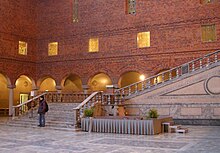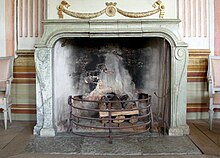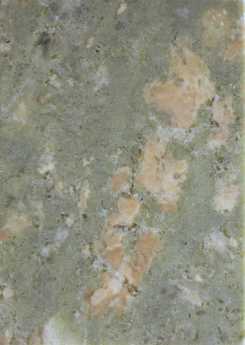Kolmården marble
The Kolmården marble ( Swedish : Kolmårdsmarmor ) is a green Swedish marble from the Kolmården region in the historic province of Östergötland , south of Stockholm . As a decorative stone, it has a special place in the architectural history of Sweden.
Deposit
The deposit consists of narrow and elongated folds of predominantly green mottled marble accompanied by adjacent layers of limestone and amphibolite rocks . These folds trains emphasize in east-west direction parallel to the bay Bråviken and swing east of the lake Svinsjö by almost 180 degrees back to the east. The most famous quarrying site is in Kolmårdens marmorbruk (sometimes just called marble bridge), not far from the shore of the bay. The marble is part of Proterozoic folds in central Sweden.
The quarrying sites in the region follow the almost vertically falling marble layers. This resulted in narrow and elongated ditch quarries, which today are mostly filled with water.
Petrography

The rock consists of calcite and minerals of the serpentine group . Accessory components are hornblende , pyroxene and minerals of the Oliving group . The composition of the rock varies. Depending on the mineral content, one can also speak of silicate marble or ophicalcite at some mining sites .
The typical expression of this stone consists of its light green color with beige or white spots and a texture with a directional structure, partly ophiolithic (snake-like). The marble can also contain dark green to black deposits.
history
The proximity of the deposit to the shores of Bråviken Bay facilitated the removal of extracted and already processed raw pieces from the beginning of the mining and in this way contributed to a more than 1000 year history of application. The art of stone carving in the Östergötland region is particularly well documented by the old baptismal fonts in some of the region's churches.
Documentary evidence of the dismantling has existed since the 16th century. A historical and hand-drawn map by S. Ryding from 1723 shows the quarry and its surrounding area along with a brief description of the occurrence. It affects a mining privilege from 1722.
During the Baroque and Classicism periods , marble was used as a popular decorative stone in castles of the Swedish royal family and the nobility. It was preferred to use it to manufacture components for stairwells, foyers as well as columns, furniture parts and individual art objects.
Since the middle of the 19th century, the development of the transport system and the improved stone processing technology have significantly increased the national shipping of Kolmården marble. The application examples listed below demonstrate this distribution.
One of the most important historical processing sites was in Erlandstorp, where there was also a mining site. There was also an old marble sawmill and polishing workshop. Other mining sites include Oxåkersbrott and Holmtorpsbrott. The narrow lines of marble in the Kolmården landscape forced it to be extracted from many small quarries with the intensive use of this marble over several centuries.
In 2007 and 2008 interested citizens of the region set up a marble museum in the dilapidated buildings of what was later the main processing site, the marble bridge, which is now closed. At this point, marble was extracted over a period of 700 years until 1978. Currently (2008) the rock is being mined by a quarry in another location in the region.
Applications




The Kolmården marble came under different names in the trade. These include a. the names Swedish Green , Kolmården OX , Vert Ringborg , Vert de Sibérie and Kolmården Nature . It is mainly used for decorative components, primarily indoors. Due to its unusual color, the marble also found international demand, for example deliveries were made to San Francisco in the middle of the 20th century . Common average sizes of the ingots for shipping were 2.5 × 1.5 × 1 meters.
In Sweden, Kolmården marble was considered a first-class material for all suitable architectural designs and artistic applications. Typical forms of application are wall and floor coverings, stairs, columns, portals, chimney facades, massive decorative components. Furniture cover plates, fountain basins or parts of them as well as historical and modern tomb designs. Utensils such as mortars were also made from this stone.
For the extraction of ashlar unsuitable extraction residues and low-value deposit areas as well as neighboring limestone deposits were used for the production of building lime . Some lime kilns have been built for this purpose.
Application examples
Sweden
Gothenburg
- University building
- Stock exchange
- Skånska Handelsbank building
Helsingborg
- Skånska Handelsbank building
Landskrona
- Skånes Enskilda Bank building
Linkoping
- Östergötlands Enskilda Bank building
Malmo
- Skånes Enskilda Bank building
Norrkoping
- St. John's Church, modern baptismal font
- Entrance portal at the Stadstornet / city tower
- Building of the Norrköping Enskilda Bank
- Standard hotel
Östra Eneby
- Church, altar (design: Kurt von Schmalensee, 1955) and old baptismal font
Söderköping
- St. Laurentii Church, baptismal font from the 14th century
Stockholm and surroundings
- Stockholms slott , wall coverings, plinths, fireplace facades, some stair balustrades, cover plates on historical furniture
- Stockholm Castle / Stockholms slott, south porch to the Rikssalen
- Town hall / Stadshus , stairs in the "Blå hallen"
- Postal Museum, Lilla Nygatan 6, exterior facade at the main entrance
- Portal of the “Tändstickspalatset” building, Västra Trädgårdsgatan 14 (architect: Ivar Tengbom ), neo-baroque facade
- Drottningholm Palace
- Rosendal Castle
- Swedish National Museum
- Nordic Museum
- Royal Opera
- Svindersvik , chimney facade
Uppsala
- University , main building, solid columns in the foyer
foreign countries
Germany
Berlin
- Berlin State Opera , Apollo Hall, floor inlays (foliage) (1832, modernized 1924–1928)
- Bristol Hotel
- Victoria Cafe
Hamburg
- Klosterburg trading house, Glockengießerwall 1 (1903–1904)
France
Paris
- Opéra National de Paris (opened in 1875)
Great Britain
Beverley
- Beverley Public Library
Glasgow
- North British Mercantile Insurance Co. building
Leeds
- University , library, solid columns in the reading room area
London
- Coliseum Theater (opened in 1904)
- Shoreditch Townhall (built in 1866, expanded in 1902)
- Church of St Savior's
- Hotel Continental (Regent Street)
- Lyons Popular Café ( Piccadilly )
United States
new York
- Rockefeller Center (started 1926)
literature
- Valter Elgeskog / Bror Asklund: Marble bridge på Kolmården . Norrköping (Norrköpings tidningars aktiebolag) 1955
- Herman Hedström: Om Sveriges naturliga byggnads- och ornamentstenar . Stockholm (PA Norstedt & Sönner) 1908
- A. Herbeck: The marble . Munich (Callwey) 1953
- Olavi Selonen / Veli Suominen: Nordic Stone . Paris, Espoo (UNESCO, IAEG, Geological Survey of Finland) 2003 ISBN 92-3-103899-0
- JH Schroeder (Ed.): Natural stone in architecture and building history of Berlin . 2nd edition, Berlin (self-published by Geoscientists in Berlin and Brandenburg eV) 2006 ISBN 978-3-928651-12-7
Web links
- Description of the marble on the website of the Swedish Geological Service (search term: Östergötland) (Swedish)
- Historical Applications (Swedish)
- Images and texts in submenus (Swedish)
- Images of the marble - submenu Kolmårdsmarmor (Swedish)
- Cultural information about the Marmorbruks Museum (Swedish)
- Photo report on the creation of the Marble Bridge Museum (Swedish)
- Concept study for the Marmorbruks Museum (Swedish)
- Geology trail of the Linköping Nature Center with information on Kolmården marble (Swedish; PDF file; 966 kB)


